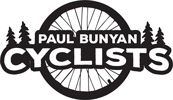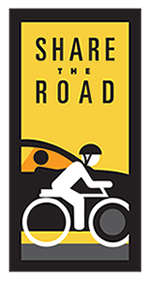be safe!
|
Here are some videos and links about bicycle safety
NHTSA's Bicycle Safety Tips for Adults - 7:23 video
Bicycle safety tips for the whole family. - 2:44 video
Share The Road - 7:58 video
|
From the Minnesota Department of Transportation Share the Road website
Safety information for drivers, bicyclists and pedestrians
Safety information for drivers, bicyclists and pedestrians
Bicyclesafe.com is a very comprehelsive website on bicycle safety
Commuting By Bike: Safety Guide & Tips on Homeadvisor.com
Commuting By Bike: Safety Guide & Tips on Homeadvisor.com
What drivers should know about sharing the road with bicyclists (and vice versa)
from the Washington Post
10 things every driver should know about sharing the road with cyclists:
●You look for pedestrians when you’re making a turn, right? Why not take a couple of seconds longer to look for a cyclist? The rider has the right of way if he’s going straight and you’re turning right.
●The bike lane serves a purpose, and it isn’t for you to park in, even for “just a couple of seconds.” When you do that, cyclists have to swerve into traffic lanes — lanes in which drivers don’t expect them because there is, after all, a bike lane.
●You may never feel more powerful than when your foot’s on the gas pedal, but if you are at fault in a collision with a cyclist — even if you just “brush” against the biker — you might lose your driver’s license for a while and your private auto insurance forever. You could be looking at criminal charges, too.
●Riders go through stop signs. It’s illegal, and it can be annoying if they do it cavalierly. Other cyclists slow down, look both ways and then roll through. Usually it’s because their shoes are mechanically attached to the pedal. Yes, they can clip out, but they opt not to.
●Don’t count on a cyclist to hear your car coming from behind. A rider is hearing a lot more noise than you are inside the car with the windows rolled up. And some foolishly listen to music while they ride. But don’t lean on the horn.
●Wonder why that bike rider stays five feet away from the row of parked cars as you’re trying to navigate a narrow street? Cyclists call it being “doored.” If someone swings open the door of a parked car, the cyclist who is too close goes down. With many drivers pausing to check text messages or finish phone calls before they get out of a car, there’s no telling when a door will pop open.
●It would be great if every street had a bike lane and every road had a wide shoulder, but they don’t. Even when they do, there are things that you might not notice that push cyclists into the traffic lane. It’s stuff you roll over — potholes, sewer grates, pavement cracks, branches, broken glass, junk that falls off cars or out of trucks and the McDonald’s bag somebody tossed out the window.
●“It’s like riding a bicycle” is a cliche for something that comes easily, but riding a bike isn’t always easy, and it takes some getting used to for riders returning to the saddle for the first time since childhood. They might not always ride the path that you expect. Capital Bikeshare has become wildly popular in the D.C. area. It puts a lot of novice or out-of-practice people on two wheels.
●A little patience could save your life. Wait to pass that cyclist until you have a clear view ahead and are sure there’s no oncoming traffic.
●Riders are supposed to stay to the right. Drivers are supposed to stay well clear of them. By law in Maryland and several other states, drivers must stay three feet from a cyclist. Don’t expect to see cops out there with a yard stick, but if you cause a crash, you could be charged with a three-foot violation.
10 things every cyclist should know about sharing the road with drivers:
●Don’t be a cowboy on a bike. If you’re an end-of-the-alphabet generation – maybe not X, but Y or Z — you might feel immortal and free to ride with the panache of a bike messenger. But inconsistent risk-taking as you zip through traffic puts more-mortal riders at peril, because it makes drivers jittery and annoyed whenever they see someone on two wheels.
●Music may be your life, it may be the grease with which you glide from day to day, but it also may be your death when those earbuds drown out that delivery van. No, listening to music with one ear and for traffic with the other is not acceptable.
●Don’t shoot up the gutter side when cars are stopped at a light. Most cyclists do it, but it’s dumb and dangerous. It also doesn’t save a whole bunch of time. If the light changes and traffic starts moving, the driver you’ve just pulled next to may be oblivious and cut you off with a turn.
●Don’t cut up between two rows of cars stopped at a light. You can end up in a heap of trouble if traffic suddenly starts rolling at 40 mph. The seconds you save aren’t worth the risk.
●Take the lane when you stop at a light or for a stop sign. Hugging the curb invites a car or truck to snug up against you, and that can be trouble when you both roll forward. The right hook — when a driver turns right and hits a cyclist who is going straight — is one of the most common crashes. Take charge of the right lane and pull off to the side after the light turns green.
● You won’t see anyone in the Tour de France wearing reflective gear or sporting flashing lights, but neither will you see too many people on the Tour course driving sport-utility vehicles while they talk on cellphones. Getting noticed is a critical survival skill.
from the Washington Post
10 things every driver should know about sharing the road with cyclists:
●You look for pedestrians when you’re making a turn, right? Why not take a couple of seconds longer to look for a cyclist? The rider has the right of way if he’s going straight and you’re turning right.
●The bike lane serves a purpose, and it isn’t for you to park in, even for “just a couple of seconds.” When you do that, cyclists have to swerve into traffic lanes — lanes in which drivers don’t expect them because there is, after all, a bike lane.
●You may never feel more powerful than when your foot’s on the gas pedal, but if you are at fault in a collision with a cyclist — even if you just “brush” against the biker — you might lose your driver’s license for a while and your private auto insurance forever. You could be looking at criminal charges, too.
●Riders go through stop signs. It’s illegal, and it can be annoying if they do it cavalierly. Other cyclists slow down, look both ways and then roll through. Usually it’s because their shoes are mechanically attached to the pedal. Yes, they can clip out, but they opt not to.
●Don’t count on a cyclist to hear your car coming from behind. A rider is hearing a lot more noise than you are inside the car with the windows rolled up. And some foolishly listen to music while they ride. But don’t lean on the horn.
●Wonder why that bike rider stays five feet away from the row of parked cars as you’re trying to navigate a narrow street? Cyclists call it being “doored.” If someone swings open the door of a parked car, the cyclist who is too close goes down. With many drivers pausing to check text messages or finish phone calls before they get out of a car, there’s no telling when a door will pop open.
●It would be great if every street had a bike lane and every road had a wide shoulder, but they don’t. Even when they do, there are things that you might not notice that push cyclists into the traffic lane. It’s stuff you roll over — potholes, sewer grates, pavement cracks, branches, broken glass, junk that falls off cars or out of trucks and the McDonald’s bag somebody tossed out the window.
●“It’s like riding a bicycle” is a cliche for something that comes easily, but riding a bike isn’t always easy, and it takes some getting used to for riders returning to the saddle for the first time since childhood. They might not always ride the path that you expect. Capital Bikeshare has become wildly popular in the D.C. area. It puts a lot of novice or out-of-practice people on two wheels.
●A little patience could save your life. Wait to pass that cyclist until you have a clear view ahead and are sure there’s no oncoming traffic.
●Riders are supposed to stay to the right. Drivers are supposed to stay well clear of them. By law in Maryland and several other states, drivers must stay three feet from a cyclist. Don’t expect to see cops out there with a yard stick, but if you cause a crash, you could be charged with a three-foot violation.
10 things every cyclist should know about sharing the road with drivers:
●Don’t be a cowboy on a bike. If you’re an end-of-the-alphabet generation – maybe not X, but Y or Z — you might feel immortal and free to ride with the panache of a bike messenger. But inconsistent risk-taking as you zip through traffic puts more-mortal riders at peril, because it makes drivers jittery and annoyed whenever they see someone on two wheels.
●Music may be your life, it may be the grease with which you glide from day to day, but it also may be your death when those earbuds drown out that delivery van. No, listening to music with one ear and for traffic with the other is not acceptable.
●Don’t shoot up the gutter side when cars are stopped at a light. Most cyclists do it, but it’s dumb and dangerous. It also doesn’t save a whole bunch of time. If the light changes and traffic starts moving, the driver you’ve just pulled next to may be oblivious and cut you off with a turn.
●Don’t cut up between two rows of cars stopped at a light. You can end up in a heap of trouble if traffic suddenly starts rolling at 40 mph. The seconds you save aren’t worth the risk.
●Take the lane when you stop at a light or for a stop sign. Hugging the curb invites a car or truck to snug up against you, and that can be trouble when you both roll forward. The right hook — when a driver turns right and hits a cyclist who is going straight — is one of the most common crashes. Take charge of the right lane and pull off to the side after the light turns green.
● You won’t see anyone in the Tour de France wearing reflective gear or sporting flashing lights, but neither will you see too many people on the Tour course driving sport-utility vehicles while they talk on cellphones. Getting noticed is a critical survival skill.


